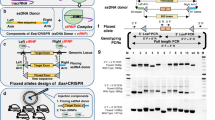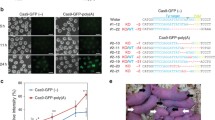Abstract
The generation of functional transgenes via microinjection of overlapping DNA fragments has previously been reported to be successful, but it is still not a widely applied approach. Here we show that the method is very reliable, and should be considered, in case a single large insert clone of the desired gene is not available. In the present study, two large DNA fragments consisting of overlapping cosmids, together constituting the human very low density lipoprotein receptor (VLDLR) gene (35 kb), were used to generate VLDLR transgenic (VLDLR-Tg) mice. Three transgenic founders were born, of which two (strain #2 and #3) generated transgenic offspring. Using Fiber-FISH analysis, the integration site was shown to contain at least 44 and 64 DNA fragments in mouse strains #2 and #3, respectively. This copy number resulted in integration sites of 1.5 and 2.5 megabase in size. Notably, over 90% of the fragments in both mouse strains #2 and #3 were flanked by their complementary fragment. In line with this observation, Southern blot analysis demonstrated that the correct recombination between fragments predominated in the transgenic insertion. Human VLDLR expression was detected in testis, kidney and brain of both mouse strains. Since this pattern did not parallel the endogenous VLDLR expression, some crucial regulatory elements were probably not present in the cosmid clones. Human VLDLR expression in testis was detected in germ cells up to the meiotic stage by in situ mRNA analysis. Remarkably, in the F1 generation of both VLDLR-Tg mouse strains the testis was atrophic and giant cells were detected in the semineferous tubuli. Furthermore, male VLDLR-Tg mice transmitted the transgene to their progeny with low frequencies. This could imply that VLDLR overexpression in the germ cells disturbed spermatogenesis.
Similar content being viewed by others
References
Argraves KM, Battey FD, MacCalman CD, McCrae KR, Gafvels M, Kozarsky KF et al. (1995) The very low density lipoprotein receptor mediates the cellular catabolism of lipoprotein lipase and urokinase-plasminogen activator inhibitor type I complexes. J Biol Chem 270: 26550–26557.
Battey FD, Gafvels ME, FitzGerald DJ, Argraves WS, Chappell DA, Strauss JF, 3rd et al. (1994) The 39-kDa receptor-associated protein regulates ligand binding by the very low density lipoprotein receptor. J Biol Chem 269: 23268–23273.
Bollag RJ, Waldman AS and Liskay RM (1989) Homologous recombination in mammalian cells. Annu Rev Genet 23: 199–225.
Davisson RL, Kim HS, Krege JH, Lager DJ, Smithies O and Sigmund CD (1997) Complementation of reduced survival, hypotension, and renal abnormalities in angiotensinogen-deficient mice by the human renin and human angiotensinogen genes. J Clin Invest 99: 1258–1264.
Florijn RJ, Bonden LA, Vrolijk H, Wiegant J, Vaandrager JW, Baas F et al. (1995) High-resolution DNA Fiber-FISH for genomic DNA mapping and colour bar-coding of large genes. Hum Mol Genet 4: 831–836.
Florijn RJ, van de Rijke FM, Vrolijk H, Blonden LA, Hofker MH, den Dunnen JT et al. (1996) Exon mapping by fiber-FISH or LRPCR. Genomics 38: 277–282.
Fort P, Marty L, Piechaczyk M, el Sabrouty S, Dani C, Jeanteur P et al. (1985) Various rat adult tissues express only one major mRNA species from the glyceraldehyde-3-phosphatedehydrogenase multigenic family. Nucleic Acids Res 13: 1431–1442.
Frykman PK, Brown MS, Yamamoto T, Goldstein JL and Herz J (1995) Normal plasma lipoproteins and fertility in gene-targeted mice homozygous for a disruption in the gene encoding very low density lipoprotein receptor. Proc Natl Acad Sci USA 92: 8453–8457.
Gafvels ME, Caird M, Britt D, Jackson CL, Patterson D and Strauss JFd (1993) Cloning of a cDNA encoding a putative human very low density lipoprotein/apolipoprotein E receptor and assignment of the gene to chromosome 9pter-p23. Somat Cell Mol Genet 19: 557–569.
Gafvels ME, Paavola LG, Boyd CO, Nolan PM, Wittmaack F, Chawla A et al. (1994) Cloning of a complementary deoxyribonucleic acid encoding the murine homolog of the very low density lipoprotein/apolipoprotein-E receptor: expression pattern and assignment of the gene to mouse chromosome 19 Feb;136(2):795. Endocrinology 135: 387–394.
Hodgson JG, Smith DJ, McCutcheon K, Koide HB, Nishiyama K, Dinulos MB et al. (1996) Human huntingtin derived from YAC transgenes compensates for loss of murine huntingtin by rescue of the embryonic lethal phenotype. Hum Mol Genet 5: 1875–1885.
Iijima H, Miyazawa M, Sakai J, Magoori K, Ito MR, Suzuki H et al. (1998) Expression and characterization of a very low density lipoprotein receptor variant lacking the O-linked sugar region generated by alternative splicing. J Biochem (Tokyo) 124: 747–755.
Jones BK, Monks BR, Liebhaber SA and Cooke NE (1995) The human growth hormone gene is regulated by a multicomponent locus control region. Mol Cell Biol 15: 7010–7021.
Kasza A, Petersen HH, Heegaard CW, Oka K, Christensen A, Dubin A et al. (1997) Specificity of serine proteinase/serpin complex binding to very-low-density lipoprotein receptor and alpha2-macroglobulin receptor/low-density-lipoprotein-receptor-related protein. Eur J Biochem 248: 270–281.
Lindstedt KA, Bujo H, Mahon MG, Nimpf J and Schneider WJ (1997) Germ cell-somatic cell dichotomy of a low-density lipoprotein receptor gene family member in testis. DNA Cell Biol 16: 35–43.
Magrane J, Reina M, Pagan R, Luna A, Casaroli-Marano RP, Angelin B et al. (1998) Bovine aortic endothelial cells express a variant of the very low density lipoprotein receptor that lacks the O-linked sugar domain. J Lipid Res 39: 2172–2181.
Migchielsen AA, Breuer ML, Hershfield MS and Valerio D (1996) Full genetic rescue of adenosine deaminase-deficient mice through introduction of the human gene. Hum Mol Genet 5: 1523–1532.
Oka K, Ishimura-Oka K, Chu MJ, Sullivan M, Krushkal J, Li WH et al. (1994) Mouse very-low-density-lipoprotein receptor (VLDLR) cDNA cloning, tissue-specific expression and evolutionary relationship with the low-density-lipoprotein receptor. Eur J Biochem 224: 975–982.
Pieper FR, deWit IC, Pronk AC, Kooiman PM, Strijker R, Krimpenfort PJ et al. (1992) Efficient generation of functional transgenes by homologous recombination in murine zygotes. Nucleic Acids Res 20: 1259–1264.
Sakai J, Hoshino A, Takahashi S, Miura Y, Ishii H, Suzuki H, Kawarabayasi Y et al. (1994) Structure, chromosome location, and expression of the human very low density lipoprotein receptor gene. J Biol Chem 269: 2173–2182.
Simonet WS, Bucay N, Lauer SJ and Taylor JM (1993) A fardownstream hepatocyte-specific control region directs expression of the linked human apolipoprotein E and C-I genes in transgenic mice. J Biol Chem 268: 8221–8229.
Takahashi S, Kawarabayasi Y, Nakai T, Sakai J and Yamamoto T (1992) Rabbit very low density lipoprotein receptor: a low density lipoprotein receptor-like protein with distinct ligand specificity. Proc Natl Acad Sci USA 89: 9252–9256.
Takahashi S, Suzuki J, Kohno M, Oida K, Tamai T, Miyabo S et al. (1995) Enhancement of the binding of triglyceriderich lipoproteins to the very low density lipoprotein receptor by apolipoprotein E and lipoprotein lipase. J Biol Chem 270: 15747–15754.
Talbot D, Collis P, Antoniou M, Vidal M, Grosveld F and Greaves DR (1989) A dominant control region from the human betaglobin locus conferring integration site-independent gene expression. Nature 338: 352–355.
Tiebel O, Oka K, Robinson K, Sullivan M, Martinez J, Nakamuta M et al. (1999) Mouse very low-density lipoprotein receptor (VLDLR): gene structure, tissue-specific expression and dietary and developmental regulation. Atherosclerosis 145: 239–251.
Trommsdorff M, Gotthardt M, Hiesberger T, Shelton J, Stockinger W, Nimpf J et al. (1999) Reeler/disabled-like disruption of neuronal migration in knockout mice lacking the VLDL receptor and ApoE receptor 2. Cell 97: 689–701.
Tuan DY, Solomon WB, London IM and Lee DP (1989) An erythroid-specific, developmental-stage-independent enhancer far upstream of the human ‘beta-like globin’ genes. Proc Natl Acad Sci USA 86: 2554–2558.
Webb DJ, Nguyen DH, Sankovic M and Gonias SL (1999) The very low density lipoprotein receptor regulates urokinase receptor catabolism and breast cancer cell motility in vitro. J Biol Chem 274: 7412–7420.
Webb JC, Patel DD, Jones MD, Knight BL and Soutar AK (1994) Characterization and tissue-specific expression of the human ‘very low density lipoprotein (VLDL) receptor’ mRNA. Hum Mol Genet 3: 531–537.
Wiegant J, Kalle W, Mullenders L, Brookes S, Hoovers JM, Dauwerse JG et al. (1992) High-resolution in situ hybridization using DNA halo preparations. Hum Mol Genet 1: 587–591.
Wong EA and Capecchi MR (1986) Analysis of homologous recombination in cultured mammalian cells in transient expression and stable transformation assays. Somat Cell Mol Genet 12: 63–72.
Author information
Authors and Affiliations
Rights and permissions
About this article
Cite this article
Tacken, P.J., Zee, A.v.d., Beumer, T.L. et al. Effective generation of very low density lipoprotein receptor transgenic mice by overlapping genomic DNA fragments: high testis expression and disturbed spermatogenesis. Transgenic Res 10, 211–221 (2001). https://doi.org/10.1023/A:1016682520887
Issue Date:
DOI: https://doi.org/10.1023/A:1016682520887




